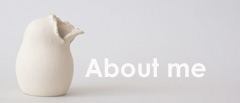Egyptian Paste was used by the Egyptians, as far back as 7,000 years ago.
Lots of items made from this material have been found in Egyptian burial tombs. Egyptian Paste is a self-glazing, low-firing clay body that was probably discovered by accident back in those days. The typical 'turquoise' color of some Egyptian jewellery might remind you of Egyptian paste.
I did this to step out of my comfort zone and it was merely an experiment. I took some pictures while making the paste and I will share 2 recipes.
I have to warn you about the end result though, it is not what I thought it would be. But it's my own mistake as I fired the pieces too high. Silly me... I knew it was a low firing clay body but didn't want to fire my 'big' kiln for a few beads on that temperature so I just stuck it in my regular firing... ;)
Here is what you need:
(recipe of Sylvia Hyman)
39 gram of Nepheline seynite
6 gram of Soda Ash (natriumcarbonate)
6 gram of Soda bicarbonate
6 gram of Kaolien (China clay)
6 gram of Ball clay
37 gram of Flint (Quarts)
2 gram of Bentonite
2 gram of Coppercarbonate
(recipe of Sylvia Hyman)
39 gram of Nepheline seynite
6 gram of Soda Ash (natriumcarbonate)
6 gram of Soda bicarbonate
6 gram of Kaolien (China clay)
6 gram of Ball clay
37 gram of Flint (Quarts)
2 gram of Bentonite
2 gram of Coppercarbonate
 But I soon found out that this is a 'short' body with little plasticity so I needed to add more water to actually be able to make small pieces with it.
But I soon found out that this is a 'short' body with little plasticity so I needed to add more water to actually be able to make small pieces with it.  I made some beads and placed them on stilts. I did this because I didn't want to place the beads on the kiln shelves as I didn't know how badly they would glaze itself.
I made some beads and placed them on stilts. I did this because I didn't want to place the beads on the kiln shelves as I didn't know how badly they would glaze itself. The above beads were made with the first recipe. It was a dry and very difficult to handle body so I tried a second recipe which turned out to be very flexible and fun to work with. Here it is:
The above beads were made with the first recipe. It was a dry and very difficult to handle body so I tried a second recipe which turned out to be very flexible and fun to work with. Here it is: 30 gram flint
30 gram quarts
40 gram bentonite
20 gram Natriumbicarbonate
4 gram copper carbonate
30 gram quarts
40 gram bentonite
20 gram Natriumbicarbonate
4 gram copper carbonate
 Let them dry thoroughly and it's important not to touch the pieces and disrupt the crystalline surface after the drying. Then fire it. Egyptian Paste is usually fired to a temperature range of 900°-1000°C (1650o - 1800o F, Cone 010 - 06) and I fired it at 1050°C.
Let them dry thoroughly and it's important not to touch the pieces and disrupt the crystalline surface after the drying. Then fire it. Egyptian Paste is usually fired to a temperature range of 900°-1000°C (1650o - 1800o F, Cone 010 - 06) and I fired it at 1050°C.This is how they came out of the kiln and obviously I knew instantly that they were fired too high as the turquoise beads (light geen, flexible paste) had a very rough surface and were not easy to get off the stilt. They can not be used for anything really as they scratch a lot.
 The black/green beads on the other hand look super - too bad that the body was so hard to work with as I love the luster that it has too it's surface.
The black/green beads on the other hand look super - too bad that the body was so hard to work with as I love the luster that it has too it's surface. I have more recipes if you are interested in trying out some.
I have more recipes if you are interested in trying out some.I certainly had fun stepping out of my comfort zone!



















